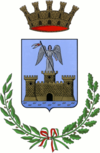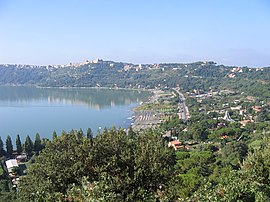Castel Gandolfo
| Castel Gandolfo | ||
|---|---|---|

|
|
|
| Country | Italy | |
| region | Lazio | |
| Metropolitan city | Rome (RM) | |
| Coordinates | 41 ° 45 ' N , 12 ° 39' E | |
| height | 426 m slm | |
| surface | 14 km² | |
| Residents | 8,869 (Dec. 31, 2019) | |
| Population density | 634 inhabitants / km² | |
| Factions | Mole di Castel Gandolfo, Pavona |
|
| Post Code | 00073 | |
| prefix | 06 | |
| ISTAT number | 058022 | |
| Popular name | Castellani | |
| Patron saint | St. Sebastian | |
| Website | Castel Gandolfo | |
 View of Castel Gandolfo and Lake Albano |
||
Castel Gandolfo (also Castelgandolfo, Latin Castrum Gandulphi) is an Italian city with 8,869 inhabitants (as of December 31, 2019), which belongs to the metropolitan city of Rome in the Lazio region.
The city is known for the papal residence located here , which has served the popes as a summer residence since the 17th century and has been open to the general public as a museum since October 21, 2016.
geography
Castel Gandolfo is located 24 km southeast of Rome in the Alban Mountains above Lake Alban . The municipality extends over a height of 155 to 519 m slm
The community is located in earthquake zone 2 (medium risk).
Castel Gandolfo is divided into four areas.
- The old town of Castel Gandolfo lies on the edge of the caldera of an extinct volcano.
- Lake Albano, which belongs to the municipality, lies on the crater floor, 130 m below the city. There are tourist restaurants and bathing beaches along the shore.
- On the western slope of the caldera is the Mole district with modern residential developments.
- In the southwest, around another, now drained crater lake (Laghetto di Turno) is the district of Pavona, which was created in the 1920s. Most of the community's residents live there today. The industrial park is also located here.
Castel Gandolfo is one of the towns of the Castelli Romani and is a member of the association I borghi più belli d'Italia (The Most Beautiful Places in Italy).
The neighboring towns are clockwise: Marino , Grottaferrata , Rocca di Papa , Albano Laziale and Rome .
traffic
-
 Castel Gandolfo is 14 km from the Monteporzio Catone junction on the motorway slip road to the A1 Autostrada del Sole motorway.
Castel Gandolfo is 14 km from the Monteporzio Catone junction on the motorway slip road to the A1 Autostrada del Sole motorway. -
 Castel Gandolfo is on the 7 Via Appia state road , which connects the place with Rome.
Castel Gandolfo is on the 7 Via Appia state road , which connects the place with Rome. -
 The Via Nettunense (state road SS 207), which crosses the Pavona district, leads to Anzio (41 km) by the sea.
The Via Nettunense (state road SS 207), which crosses the Pavona district, leads to Anzio (41 km) by the sea.
-
 Castel Gandolfo has a train station on the FL4 Rome-Albano regional line . Pavona station on the FL4 Rome-Velletri regional line is already in the Pavona district of Albano Laziale.
Castel Gandolfo has a train station on the FL4 Rome-Albano regional line . Pavona station on the FL4 Rome-Velletri regional line is already in the Pavona district of Albano Laziale.
history
Archaeological excavations and historical sources suggest that around 1100 BC on the site of today's location Until 600 BC The ancient city of Alba Longa , which was the cultural center and capital of the Latin Association for a long time . Alba Longa played a prominent role in Roman mythology in founding Rome. 665 BC Alba Longa was destroyed by Rome.
Also due to the favorable location on the Via Appia (built from 312 BC) numerous villas were built in the area, including the villa of Emperor Domitian as the largest . It is the predecessor of today's Papal Palace.
In the Middle Ages, the Domitian villa belonged to the Counts of Tusculum under the name of Massa Caesariana . In 1221 they acquired the Savelli and converted them into their castle. In 1596 it was confiscated by the Apostolic Chamber due to unsettled debts of the Savelli family and subsequently converted into a baroque palace. Since 1628 it has been used as the Pope's summer residence.
When Castel Gandolfo was occupied by French soldiers in 1798, it joined the short-lived Republic of Albano. In 1870 the Papal State was dissolved and Castel Gandolfo was incorporated into the Kingdom of Italy .
Population development
| year | 1881 | 1901 | 1921 | 1936 | 1951 | 1971 | 1991 | 2001 | 2011 | 2016 |
|---|---|---|---|---|---|---|---|---|---|---|
| Residents | 1767 | 1980 | 2577 | 2955 | 4172 | 4709 | 6843 | 7930 | 9091 | 8971 |
Source: ISTAT
politics
Milvia Monachesi ( PD ) was elected mayor in May 2012 and confirmed in office in June 2017. Her predecessor and party friend Maurizio Colacchi was in office from 2002 to 2012. In the elections in 2002, 2007 and 2012, the red-green Arcobaleno (rainbow) citizens' list always won an absolute majority of the seats in the municipal council. In 2017, the successor list, Insieme (Together) , won 8 of the 12 municipal council seats.
Twin cities
-
 Châteauneuf-du-Pape , the former summer residence of the Popes in Provence
Châteauneuf-du-Pape , the former summer residence of the Popes in Provence
-
 Curepipe in Mauritius
Curepipe in Mauritius
religion
The majority of the inhabitants of Castel Gandolfo belong to the Roman Catholic religious community. The city belongs to the diocese of Albano .
Papal residence
Castel Gandolfo is home to a Pope's residence . Originally built by Emperor Domitian , it was later the aristocratic residence of the Gandolfi family and then the Savelli. The residence was confiscated by Pope Clement VIII in 1596 and converted into a papal palace under Urban VIII from 1624 to 1629. Since then, the palace has been used as a residence by almost all popes, especially in the summer months. Traditionally, the general audiences also take place there in the inner courtyard of the Papal Palace. Pope Benedict XVI During his pontificate, he often used the residence for recreation throughout the year. After resigning from office on February 28, 2013, he retired to Castel Gandolfo until he finally took his retirement home in the Mater Ecclesiae monastery on May 2, 2013 . In the summer of 2015, Pope emeritus Benedict XVI. the residence again for a two-week stay. Castel Gandolfo is the place of death of Pius XII. (1958) and Paul VI. (1978).
The residence is a complex of three villas. In the Lateran Treaties of 1929, the summer residence (which includes the Papal Palace, Villa Cybo, Villa Barberini, the Belvedere gardens, and a manor with a small farm) was designated as the extraterritorial property of the Holy See (with an area of 55 hectares) . The security tasks within the papal property are carried out by the Vatican gendarmerie . The "International Mariapoli Congress Center" of the Focolare Movement is located in the area of Villa Cybo . At the beginning of the pontificate of John Paul II , an indoor swimming pool was donated by American Catholics.
The Vatican observatory Specola Vaticana has been located in the east wing of the complex since 1930. It replaced the Roman observatory because of the light pollution in the city. It has two telescopes from the 1950s, but they are now out of date. Therefore, in 1981 the research department of the institute was relocated to the university there in Arizona by its then director George Coyne .
In October 2016, Pope Francis announced that he would no longer use Castel Gandolfo as a summer residence in the future. On October 21, 2016, the papal apartment was converted into a museum open to the public.
Legal status
According to the Lateran Treaty of 1929, the papal residence in Castel Gandolfo and the papal goods are not part of the territory of the Vatican City State , but Italian territory, which is owned by the Holy See . The national territory enjoys extraterritoriality and is therefore comparable to diplomatic missions : It is exempt from Italian taxes and expropriations, Italian authorities are not allowed to enter them without the consent of the Holy See. The treaty describes this as extraterritoriality , a term that is no longer used in international law today due to its ambiguity.
Parish Church of San Tommaso da Villanova by Gian Lorenzo Bernini
literature
- Christoph Henning: Lazio. The land around Rome. With walks in the Eternal City (= DuMont art travel guide ). 3rd, updated edition. DuMont, Cologne 2006, ISBN 3-7701-6031-2 .
- Anton Henze, Kunibert Bering, Gerhard Wiedmann: Art guide Rome. 5th, revised edition. Philipp Reclam GmbH, Stuttgart 1994, ISBN 3-15-010402-5 .
- Mario Galgano : Castel Gandolfo - Where Popes go on vacation. 1st edition. Kunst-Verlag Fink, 2015.
Web links
- Castel Gandolfo on www.comuni-italiani.it (Italian)
- On the history of the Papal Palace
- Article on the history of the papal summer palace by René Schlott at Spiegel Online
Individual evidence
- ↑ Statistiche demografiche ISTAT. Monthly population statistics of the Istituto Nazionale di Statistica , as of December 31 of 2019.
- ↑ State Archives In 1994 Castel Gandolfo received city rights
- ^ Italian civil defense
- ^ I borghi più belli d'Italia. Borghipiubelliditalia.it, accessed August 31, 2017 (Italian).
- ^ Christian Hülsen : Alba Longa . In: Paulys Realencyclopadie der classischen Antiquity Science (RE). Volume I, 1, Stuttgart 1893, Col. 1301 f.
- ^ Gisela MA Richter : Alba Longa (Castel Gandolfo) Latium, Italy . In: Richard Stillwell et al. a. (Ed.): The Princeton Encyclopedia of Classical Sites. Princeton University Press, Princeton NJ 1976, ISBN 0-691-03542-3 .
- ^ Information from the Ministry of the Interior , accessed on January 11, 2016
- ^ Information from the Ministry of the Interior , accessed on January 12, 2018
- ^ Diocese of Albano (Italian), accessed December 20, 2015
- ↑ Castel Gandolfo is upgrading: “Everyone is excited about Benedict XVI. opposite". Vatican Radio , February 22, 2013, accessed February 22, 2013 .
- ↑ Pope Francis is called Benedict XVI. welcome to the Vatican. Vatican Radio , May 3, 2013, accessed May 4, 2013 .
- ↑ Pope renounces his summer residence at Castel Gandolfo
- ^ The papal summer residence becomes a museum
- ^ Lateran Treaty ( http://www.verfassungen.eu/va/lateranvertrag1929.htm ), Article 15 and Appendix II.









